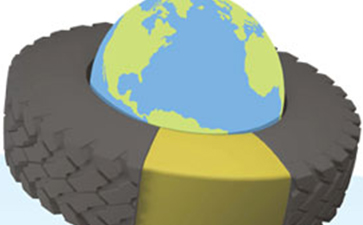Flashback: The TyrFil Roof Experiment
In the seventies, the United States Government was now heavily involved in the development of the Interstate Highway System. In addition to the building of highways in every state, shopping malls, housing developments, and construction sites were everywhere. Sales of Off-the-Road (OTR) tires were “booming”, in fact, the demand for new large OTR tires increased so much that the tire manufacturers were unable to meet the demand.
By 1974, early TyrFil adopter, Brad Ragan, Inc (BRI), had grown exponentially during this time through acquisition of other tire companies and through new tire and retread sales to construction companies that were working on the Interstate Highway Systems. BRI began to manufacture large boom trucks and equipment to service the construction sites. The boom trucks were an original idea, for up to now, tires were smaller and did not require the lifting devices.
Mr. Ragan was introduced to flatproofing by Russ Chandler, Vice President of Mitchell Tire Company (MITCO). Mr. Chandler sought employment at BRI. He wanted to open a location in Chattanooga, TN to market a new revolutionary product, polyurethane flatproofing. Prior to 1975, BRI had made and sold a “foam” manufactured in Radford, VA to help prevent flat tires. The foam, a DuPont formulation, grew inside the tire when the formulation was placed in a heat chamber. But this “foam” product had many problems. The PSI within the foam filled tire was not consistent. The foam also would develop flat spots within the carcass, when placed under load. The material failed miserably when sidewall cuts occurred and the foam erupted though the tire injury like a “mushroom”. And there was also a very serious accident in the Radford Plant in 1972, when the material exploded and seriously burned an employee.
Although there were serious negative connotations around the “foam” solution to prevent flats at this time due to the BRI product, Mr. Ragan told Sam Capps, a pioneer in the flatproofing industry, to hear what Russ had to say. Russ explained the significant differences between polyurethane flatproofing and the BRI foam product. First, the entire cavity of the tire was filled with the two-part polyurethane liquids. Then in a few hours, it would cure into a solid elastomer that would flex similarly to a pneumatic tire. Lastly, a polyurethane-filled pneumatic tire would never go flat and the PSI would be consistent.
Mr. Capps was initially hesitant to try out this new product, but he had been observing that the pneumatic tires experienced many flats in the severe and hostile construction environments. The flats resulted in costly downtime and service costs to the end user. Flatproofing could easily fit into the changing and growing OTR tire market. The earthmoving equipment was rapidly changing from track and metal wheels to air-filled tires, and he believed that urethane flatproofing would definitely lead to new tire and service sales for BRI. So, he advised Mr. Ragan to hire Mr. Chandler, open up a location in Chattanooga, and begin purchasing, processing, and selling urethane flatproofing fill. Mr. Ragan’s response, “Sammy, I am glad that you and I agree, cause I was going to do it anyway.”
The Grand Roof Experiment
Mr. Ragan ordered a pump and some material. He wanted to try it out first before the company went hog wild with the product. One of the first experiments was a roof leak at the Winona, Michigan location. Water was dripping into the plant and was creating some manufacturing and safety problems. The estimate for repairing the roof was in excess of $75,000. Mr. Ragan said, “Don’t call the roofers yet. I’ve got a better idea. We’ll repair it ourselves.” Dallas Backhus, manager of this location, asked “Mr. Ragan, do we now have a roofing division?”
Mr. Ragan said, “Dallas! You got one of those new pumps and some drums of that new urethane fill material, don’t you?”. Dallas said, “Yes sir. Just got it.” Mr. Ragan said, “Well! Take the pump and the liquid onto the roof and spread that stuff all over. Now tell your man not to spray himself into a corner. Hate to have you call the Fire Department and explain to them what we are doing.” Dallas, after some questions, agreed to do this the following Monday.
When the phone call was completed, Sammy told Mr. Ragan that the urethane fill was not intended to fix roofs, but tires. But Mr. Ragan argued, “Sammy, I just read in the literature that the material was guaranteed to stop leaks. That’s what we’re going to do! Stop leaks!”. Sammy shrugged his shoulders and said nothing else.
About three or four days later, Sammy was once again in Mr. Ragan’s office when Dallas called. This time, Mr. Ragan had him on speaker phone. Dallas said, “Mr. Ragan! We have a problem, a BIG problem! You know how our plant is adjacent to the lake. Well the new material stopped the leaks from the rain, alright, but we now have several pigeons trapped in the sticky material on the roof.”
This was serious, so Mr. Ragan grabbed the phone and clicked off the speaker so that he could talk privately. Sammy heard him ask, “What are the pigeons doing?” Then I heard him say, “You say they just a standin’ there flappin’ their wings?” It was hard for Sammy to keep a straight face and then he heard Mr. Ragan say to Dallas, “You have your man go down to the local hardware store, buy one of them electric hedge clippers and go to the roof and cut those birds legs off. They will then fly away. Okay?” Mr. Ragan laughed when he hung up the phone. Sammy asked, “What did Dallas say when you told him that? Mr. Ragan said, “He had nothing to say.” Sammy thought to himself, what could he say?
This story has been told in the tire circles many times over the years, but the rest of the story has seldom been told. It did have a happy ending for the pigeons, but not so much for BRI. The BRI personnel in Winona waded through the sticky mess and freed the trapped birds. But the Winona facility would later pay almost $100,000 instead of the original $75,000 to fix and repair the roof after Mr. Ragan’s suggestion did not work. After this incident, the pump and material were later transferred to another location.
In the weeks that followed, Mr. Ragan did not give up on his TyrFil experiments. One less extreme experiment was trying the material on furniture repairs, making tables steady by placing a “glob” of material (as he would say) under a table leg that was sitting unevenly on the floor. He experimented many times in tire retreading, using it in section repairs and in sealing punctures. He even tried making a solid tire out of it. After many failed experiments, the pump finally was shipped to another BRI location where it was used as intended to flatproof tires.


